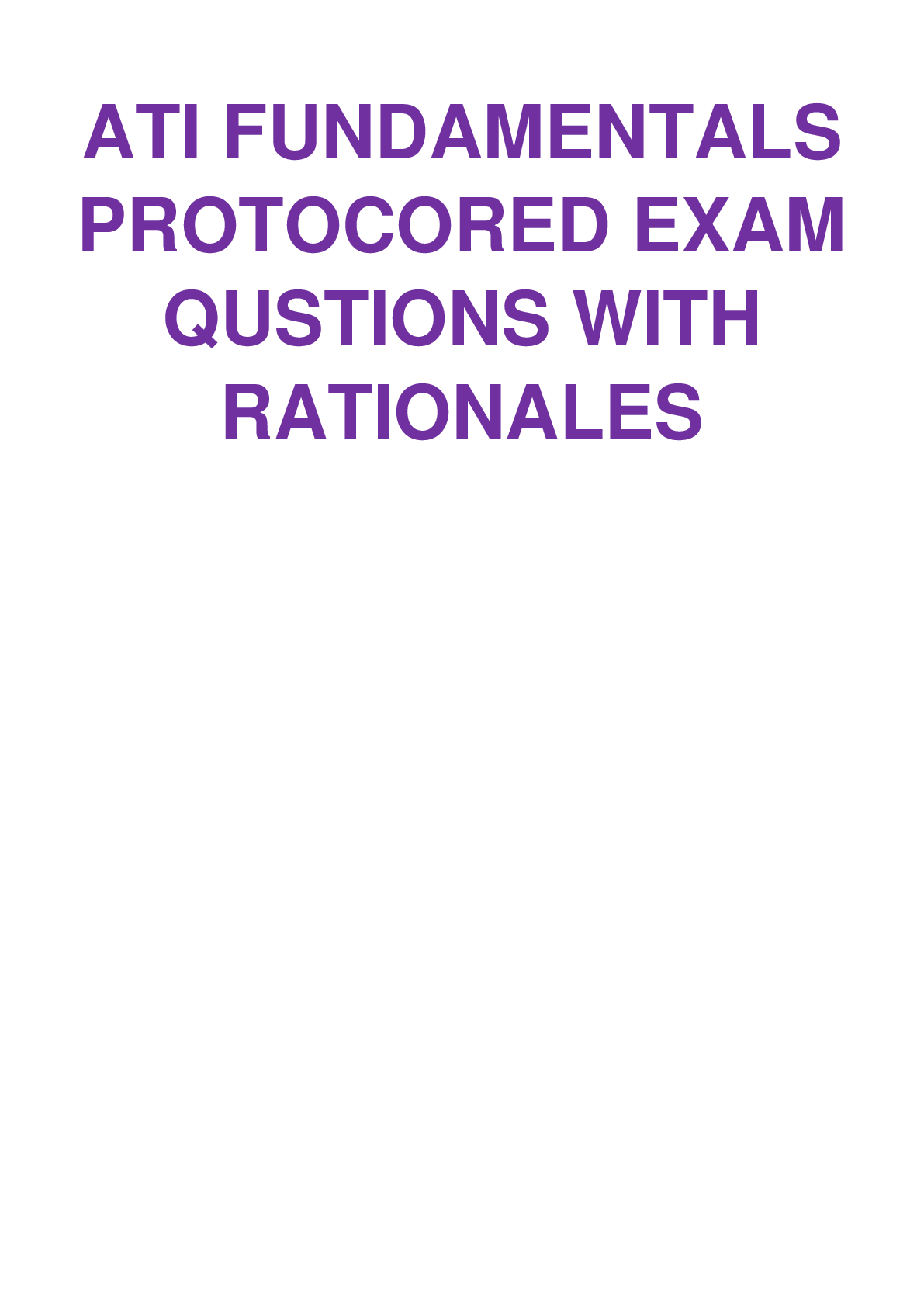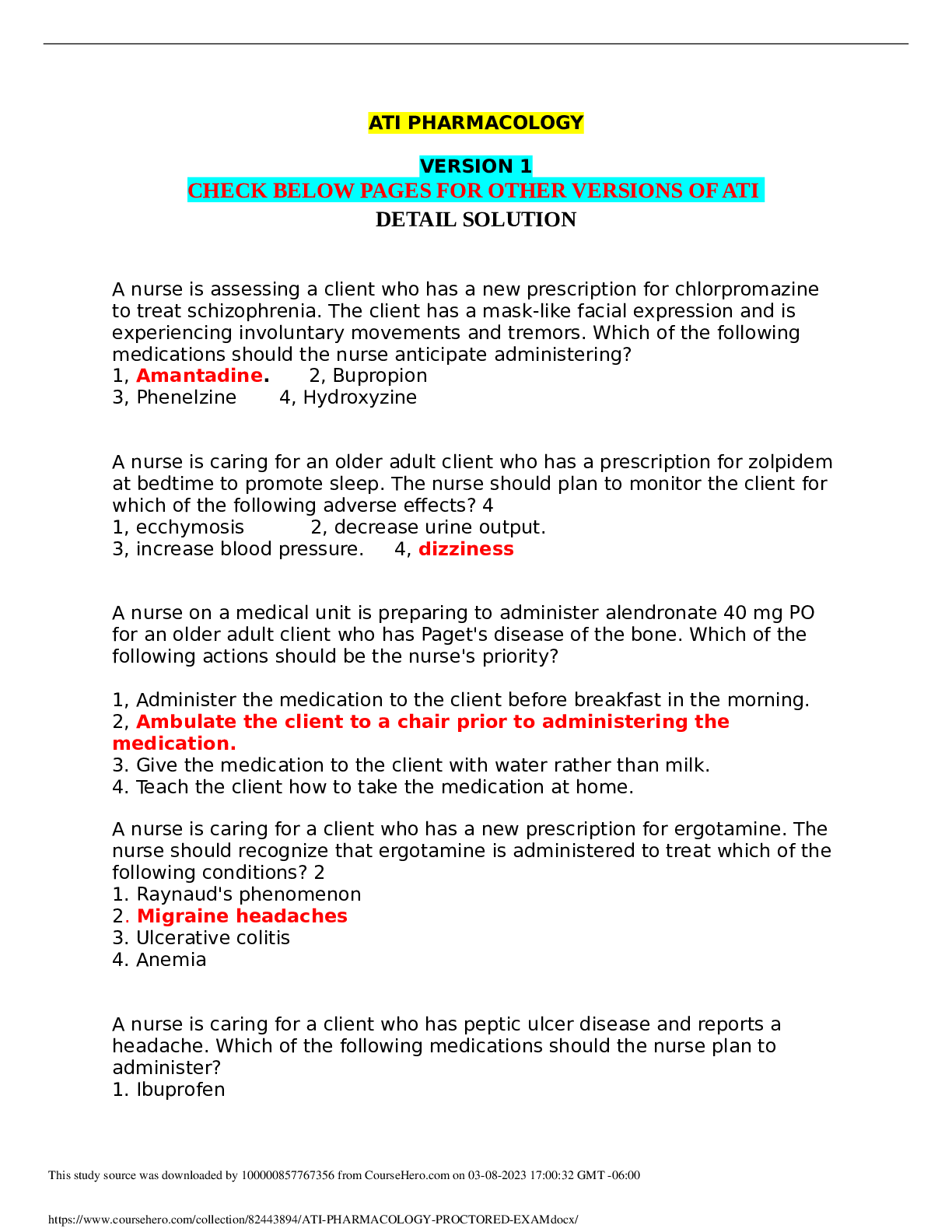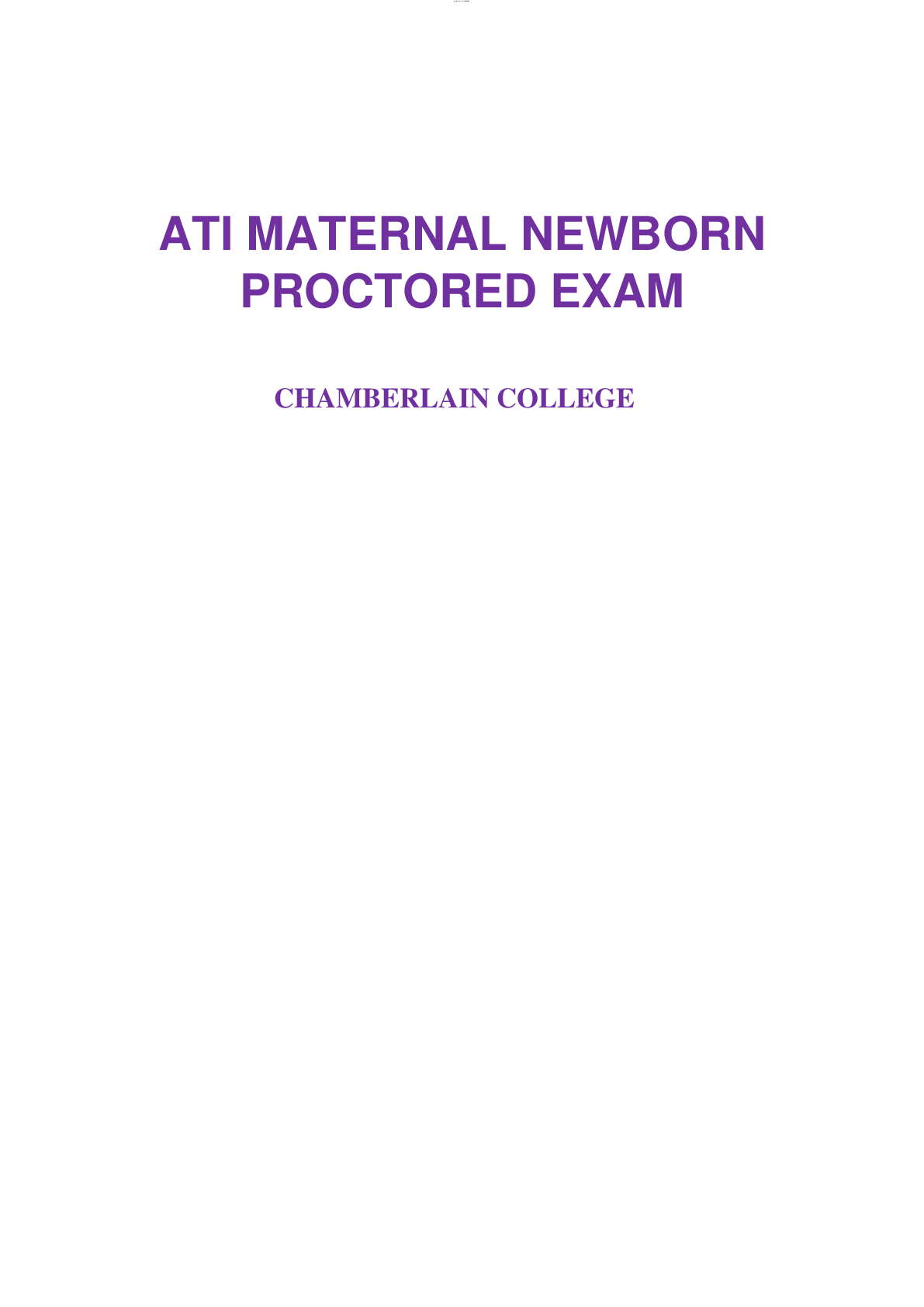Pharmacology > ATI > Pharmacology ATI Proctored Exam Questions and Answers (All)
Pharmacology ATI Proctored Exam Questions and Answers
Document Content and Description Below
Benzodiazepines - ANSWER Includes "Pams" Alprazolam, diazepam, lorazepam, oxazepam, clonazepam, chlordiazepoxide, chlorazepate Enhances GABA: increased GABA means decreased neuron activity Treats an... xiety, PTSD, seizures, alcohol withdrawal, muscle spasm, induction of anesthesia Usually short term; if long term do NOT stop abruptly Antidote is flumazenil Side effects: CNS depression - sedation and respiratory depression, amnesia, dependency, and withdrawal effects Atypical anxiolytic - ANSWER Buspirone Can take 2-6 weeks to work, but can be long term! Treats panic disorder, anxiety, OCD, and PTSD Side effects: dizziness, nausea (take w/ food to relieve), headache (sedation and dependency is not seen like in benzo) Trick to remember difference between Benzodiazepine and buspirone - ANSWER "Pam" has anxiety, so she goes on a "benzo" and takes it for a long time but realizes that it is not healthy. So she takes a "bus" to a "pier" to sit "alone" and decides to treat her anxiety long term with "buspirone" Selective Serotonin Reuptake Inhibitors (SSRIs) - ANSWER Usually end in "ine": paroxetine, sertraline, citalopram, escitalopram, fluoxetine, fluvoxamine Inhibits serotonin reuptake" increases serotonin Treats anxiety, OCD, PTSD, and depression Side effects: nausea, fatigue, sexual dysfunction, weight gain, insomnia (paroxetine), serotonin syndrome (agitation, hallucinations, tremors, fever, diaphoresis) Takes about four weeks after treatment begins to take full effect. Atypical Antidepressants - ANSWER Bupropion, Trazodone - more important Others: Vilazodone, mirtazapine, reboxetine Treats depression and aid for smoking cessation Side effects: headache, GI distress, insomnia, nausea, weight loss, seizures Tricyclic antidepressants - ANSWER Amitriptyline Treats depression, neuropathic pain, fibromyalgia, anxiety disorders, insomnia Side effects: Anticholinergic effects, Sedation, Seizures, Sweating (SSS) "Amy tripped over a tricycle in the desert." Amitriptyline is a tricyclic antidepressant and causes effects that make you feel like you're in the desert. Anticholinergic efffects - ANSWER dry mouth, blurred vision, photophobia, urinary hesitancy or retention, constipation, tachycardia Monoamine oxidase inhibitors - ANSWER Phenelzine (Prototype), Isocarboxazid, tranylcypromine, selegiline Side effects: CNS stimulation, Orthostatic hypotension, hypertensive crisis (especially with phenelzine). Tyramine rich foods can lead to hypertensive crisis Foods that contain tyramine - ANSWER aged cheese, pepperoni, salami, avocados, figs, bananas, smoked fish, protein dietary supplements, soups, soy sauce, some beers, and red wine Mood stabilizer - ANSWER Lithium Carbonate Treats bipolar disorder Side effects: GI distress, fine hand tremors, polyuria, weight gain, renal toxicity, renal toxicity, hypothyroidism, electrolyte imbalance Lithium toxicity: occurs with levels over 1.5; presents with COARSE (not fine) hand tremors, confusion, tinnitus, seizures, hypotension, coma, possibly death. Do not give with diuretics, NSAIDs, or anticholinergics Need a balance of sodium and water. Mood - stabilizing antiepileptic - ANSWER Carbamazepine, valproic acid Treats Bipolar disorder and seizure disorder Carbamazepine side effects: blood dyscrasias, hypo-osmolality Valproic acid side effects: *hepatotoxicity,* pancreatitis, thrombocytopenia Antipsychotics: First-generation (conventional) - ANSWER Chlorpromazine, Haloperidol TONS of side effects-will only list important ones Extrapyramidal side effects: Acute dystonia- spasms of tongue, neck, face, or back; Parkinsonism- rigidity, shuffling gait, drooling, tremors; akathisia- unable to sit or stand still; tardive dyskinesia - involuntary movement of tongue and face EPS effects may be able to be treated with anticholinergic medication if the patient does not have anticholinergic side effects. Neuroleptic Malignant Syndrome: sudden high grade fever, dysrhythmias, muscle rigidity There is a long lasting injection for non-compliant patients. Antipsychotics: second and third generation (atypical) - ANSWER Risperidone and Clozapine - most important Often first line in treating schizophrenia Treats negative and positive symptoms Side effects: diabetes mellitus, weight gain, hypercholesterolemia, orthostatic hypotension, anticholinergic effects Do not take with alcohol. IM every two weeks available for those who are not compliant Central Nervous system stimulants - ANSWER Methylphenidate and Amphetamine mixture Treats ADHD and Conduct disorder Can cause insomnia, decreased appetite, weight loss, and growth suppression Do not give at night. Give immediately before or after a meal. Monitor weight. Medications to support withdrawal from alcohol - ANSWER Benzodiazepines: Chlordiazepoxide, lorazepam, diazepam First line treatment of alcohol withdrawal Keeps vitals within expected limits, decreases risk of seizures Clonidine and Propranolol depress autonomic response and decrease vitals Carbamazepine Further decreases risk of seizure Disulfiram - ANSWER Daily oral medication to sustain abstinence of alcohol; type of aversion therapy Causes nausea, vomiting, sweating, palpitations, and hypotension if alcohol is consumed Naltrexone - ANSWER Suppresses the craving and pleasurable effects of alcohol. Can have monthly IM injection Acamprosate - ANSWER Decreases unpleasant effects resulting from abstinence like dysphoria, anxiety, restlessness Medications to support withdrawal/abstinence from opiods - ANSWER Methadone Substitution Slow weening process Methadone substitution is an oral opioid agonist that replaces the opioid to which the client has a physical dependence It prevents abstinence syndrome and removes the need for the client to obtain illegal substances. Used for withdrawal and long term maintenance. Withdrawal/abstinence from nicotine - ANSWER Bupropion Nicotie gum, patch, or nasal spray Varenicline: a nicotine receptor agonist. Reduces cravings as well as withdrawal effects. Depression and suicidal effects can occur. Cholinesterase inhibitors - ANSWER Neostigmine, Physostigmine, Edrophonium (dx MG) Prevents the enzyme cholinesterase from inactivating acetylcholine thereby increasing the amount of ACh available. Treats myasthenia gravis and parkinson's Reversal for neuromuscular blocking agents Excessive muscarinic stimulation: increased GI motility, diaphoresis, increased salivation, bradycardia, and urinary urgency (too moist) Cholinergic crisis: give atropine! Atropine reverses this! Levodopa/Carbidopa - ANSWER Giving together to increase dopamine Used for parkinson's Decreases tremors and muscle rigidity Levodopa is converted to dopamine in the CNS and carbidopa prevents the breakdown of levodopa Side effects: quite a few: nausea, vomiting, drowsiness, dyskinesia, orthostatic hypotension, darkening of urine and sweat, possible psychosis High protein meals decreases effectiveness. Benztropine - ANSWER Decreases Acetylcholine Used for Parkinson's, helps with muscle rigidity and tremors Side effects relate to too little acetylcholine which means we will have anticholinergic side effects Teach to chew gum, wear sun glasses, increase fiber and fluids Antiepileptics - ANSWER Phenytoin, Carbmazepine, Valproic acid, lamotrigine Phenytoin: Side effects: gingival hyperplasia!, diplopia, stigmas, rash, ataxia, hypotension Closely monitor plasma levels! Narrow range! Range is 10-20 mcg/mL Decreases effectiveness of oral contraceptives. Neuromuscular Blocking Agent - ANSWER Succinycholine and Pancuronium Blocks acetylcholine at the neuromuscular junction resulting in muscle relaxation and hypotension. They do not cross the blood brain barrier, so complete paralysis is achieved without loss of consciousness or decreased pain sensation. Used in anesthesia. Side effects: respiratory depression, prolonged apnea, muscle pain, and malignant hyperthermia (MH) MH: muscle rigidity with increased temperature. Need to give oxygen at 100%, initiate cooling measures and administer dantrolene. Peripherally acting muscle relaxants - ANSWER Dantrolene Treats: spasticity related to cerebral palsy, spinal cord injury, and multiple sclerosis Inhibits muscle contraction by preventing release of calcium in skeletal muscles. Side effects: drowsiness, muscle weakness, hepatic toxicity Centrally Acting muscle relaxants - ANSWER Baclofen (diazepam, baclofen, cyclobenzaprine, tizanidine) Used for muscle spasticity related to spinal injury cerebral palsy, multiple sclerosis, as well as malignant hyperthermia Enhances effect of GABA Drowsiness, GI upset, constipation (increase fiber and fluid) Urinary Tract Stimulant - ANSWER Bethanechol (Cevimeline, pilocarpine, acetycholine) "Beth has is shy and has a shy bladder" Used for nonobstructed urinary retention. Stimulates the cholinergic receptors in GU tract. Side effects: r/t cholinergic effects like flushing, sweating, urinary urgency, bradycardia, hypotension One hour before or two hours after meal, not at meal time Muscarinic antagonist - ANSWER Oxybutynin (darifenacin, solifenacin, tolterodine, fesoterodine, trospium) Used for overactive bladder symptoms: frequency, urgency, nocturia Inihibts muscarinic receptors Side effects: Anticholinergic! Nonbenzodiazepines for insomnia - ANSWER Zolpidem Enhances GABA Can cause day time sleepiness and dizziness. Ensure they have eight hours of sleep. Intravenous anesthetics - ANSWER Pentobarbital: Barbiturate Medazolam: Benzo Propofol Initiate or maintain anesthesia, conscious sedation, intubation Depresses CNS, promote loss of consciousness Side effects: respiratory/cardiac depression. Propofol: pain at IV site, high risk of infection. Use within six hours For all: have rescue equipment available and constantly monitor EKG and vitals. Beta2-adrenergic agonist - ANSWER Albuterol and salmeterol Bronchodilation Treats COPD and asthma Side effects: Tachycardia, angina, tremors Albuterol - short acting; salmeterol - long acting If using with a glucocorticoid, use beta2-adrenergic agonist first to dilate the bronchioles MethylXanthines - ANSWER Theophylline "Theo means God and if you use this, you may be seeing God sooner than you intended due to side effects." Can be used long term for asthma or COPD Side effects: GI upset, fatal dysrhythmia, and seizures Narrow therapeutic range: frequent blood draws: 5-15 mcg/mL Inhaled anticholinergics - ANSWER Ipratropium Used for asthma or COPD; blocks acetylcholine to bronchodilate Side effects: anticholinergic - dry mouth and hoarseness Increase fluid intake and suck on sugarfree candy. Inhaled Glucocorticoids - ANSWER Beclomethasone Used for asthma; can be used alone or with beta 2 agonist Decrease inflammation locally Side effects: hoarseness and candidiasis Rinse mouth out after the medication is used Oral glucocorticoids - ANSWER *Prednisone* Used for asthma, autoimmune disorders and a variety of inflammatory disorders Suppresses inflammation and immune response Side effects: weight gain, bone loss, immune suppression, fluid retention, hyperglycemia, hypocalcemia, infection, muscle weakness, peptic ulcer disease, and adrenal gland suppresion Periods of stress may require a higher dose NEVER stop this medication abruptly, it will need to be tapered Monitor for signs and symptoms of infection Avoid NSAIDs Leukotriene modifiers - ANSWER Montelukast (Zafirlukast, Zileuton) Treats exercise induced asthma "Lukast will decrease the effect of Leukotrienes" Reduces airway inflammation and bronchoconstriction by decreasing leukotrienes Side effects: increased liver enzymes with Zafirlukast Take in the evening or two hours before exercise Antitussives: Opioid - ANSWER Codeine (hydrocodone) Used for non-productive cough Decreases cough reflex Side effects: sedation, respiratory depression, GI upset, possible dependency Change positions slowly, increase fluid and fiber, and avoid alcohol Expectorants - ANSWER Guaifenesin "Guaif sounds like cough" Used for non-productive cough associated with respiratory infections; thins secretions to enable patient to cough up mucous Side effects: GI upset, possible rash, drowsiness Want patient to drink more fluids to help liquefy secretions Mucolytics - ANSWER Acetylcysteine Used for pulmonary disorders where there are thick mucous secretions such as in cystic fibrosis; improves flow of secretions Also used for acetaminophen toxicity Side effects: bronchospasm, rash, nausea, vomiting Use cautiously in patients with asthma Decongestants - ANSWER Phenylephrine (pseudoephedrine, ephedrine, naphazoline) Used for rhinitis Causes vasoconstriction and decreases mucous in nose Side effects: agitation, nervousness, palpitations, increased heart rate, rebound congestion Antihistamines - ANSWER 1st gen: diphenhydramine 2nd gen: Loratadine Used for nasal congestion, mild allergic reactions, and motion sickness Blocks histamine release which helps reduce mucous secretion With 2nd gen - less side effects Side effects with 1st gen: anticholinergic effects and sedation Nasal glucocorticoids - ANSWER Mometasone (fluticasone, triamcinolone, budesonide) Used for rhinitis; decreases inflammation in nasal passages Side effects: burning, headache, sore throat Loop diuretics - ANSWER Furosemide Blocks re-absorption of sodium and water at ascending loop of henle causing rapid diuresis. Used for pulmonary edema, heart failure, and hypertension Side effects: hypotension, hyponatremia, and hypokalemia, ototoxicity, dehydration and hypergllycemia Administered in the morning or during day, not at night Infuse IV at 20 mg/min Weigh daily Monitor I&Os Watch electrolyte labs Encourage high potassium foods Thiazide Diuretics - ANSWER Hydroclorothiazide Blocks re-absorption of water and sodium at distal convoluted tubule. Used for Hypertension, edema side effects: dehydration, hypokalemia, hyperglycemia Admin during day, \ Monitor I&Os Watch electrolyte labs Encourage high potassium foods Potassium sparing diuretics (Aldosterone Antagonist) - ANSWER Spironolactone Blocks aldosterone promoting excretion of sodium and water ONLY Used for heart failure, hypertension Contraindication in severe kidney failure Side effects: hyperkalemia, issues with menstruation, gynecomastia or impotence in men Monitor potassium closely and avoid salt substitutes Osmotic Diuretics - ANSWER Mannitol Treats Edema, increased ICP, increased IOP Contraindicated in intracranial hemorrhage "Oh man I had a bad headache because of increased cranial pressure, but man it all went away when I took mannitol" Reduces ICP and IOP by increasing serum osmolality Side effects: Heart failure, pulmonary edema, renal failure, dehydration, electrolyte imbalances Use filter needle and tubing when admintering Monitor weight, I&Os, and electrolytes Angiotensin - converting enzyme inhibitors - ANSWER Captopril "-pril"s Blocks conversion on angiotensin one into angiotensin two, which vasodilates Treats HTN, HF, MI, diabetic retinopathy Side effects: Angioedema, Cough, Elevated potassium (A.C.E.), rash, hypotension Closely monitor blood pressure Change position slowly Angiotensin II Receptor Blockers - ANSWER Losartan "Sartans" Blocking action of angiotensin II; results in vasodilation Heart failure, HTN, MI, diabetic retinopathy Side effects: angioedema, GI upset, hypotension Direct Renin Inhibitors - ANSWER Aliskiren Calcium Channel Blockers - ANSWER Diltiazem, Nifedipine, Verapamil Used for HTN and angina; block calcium channels in the blood vessels and heart cause vasodilation and decreased heart rate Side effects: hypotension, bradycardia, dysrhythmias, constipation, edema Patient should NOT consume grapefruit juice Monitor blood pressure and heart rate regularly Alpha adrenergic blockers - ANSWER Prazosin Centrally Acting Alpha2 agonist - ANSWER Clonidine (do not confuse with clonzapine) Activate Alpha II receptors which cause decrease in heart rate and blood pressure Treats HTN Side effects: drowsiness and dry mouth Beta Blockers - ANSWER Metoprolol "lol" HTN, angina, heart failure, MI; blocks beta 1 receptors in heart which decreases heart rate and blood pressure Side effects: hypotension, bradycardia, decrease output, fatigue, erectile dysfunction Teach to take pulse and change position slowly. If beta blocker is non-selective: it will cause bronchospasm and should not be used in asthma. These include Propranolol and Nadoll Hypertensive Crisis - ANSWER Nitroprusside Directly vasodialates arteries and veins which rapidly decreases blood pressure by acting on preload and afterload Side effects: hypotension, cyanide poisoning, thiocyanate toxicity Cardiac glycocides - ANSWER Digoxin Used for heart failure and A-fib Positive inotropic effect: increase in force and efficiency of heart contractions Negative chronotropic effect: decreases heart rate Side effects: dysrhythmias, bradycardia Toxicity: GI upset, vision changes, and fatigue/weakness Always check apical pulse for full minute before giving and hold if under 60 Monitor serum levels: should be between 0.5 - 2.0 Hypokalemia increases risk for digoxin toxicity Treat bradycardia with atropine and overdose with activated charcoal, cholestyramine, or digoxin immune Fab (digibind) Adrenergic agonist - ANSWER Epinephrine, dopamine, and dobutamine (PT: Catecholamines) Epinephrine: Stimulates Alpha-1, Beta-1, and Beta-2 receptors. Used for cardiac arrest or asthma. Bronchodilates, vasoconstriction, increased cardiac output, and increases heart rate Dopamine: Used for shock and heart failure. Increases renal blood flow at low to moderate doses. Increase heart rate and cardiac output. Dobutamine: Primarily stimulates Beta-1 receptors and acts on heart. Used for heart failure. Increases cardiac output. Less effect on blood pressure and heart rate Side effects: hypertensive crisis, dysrythmias, angina Organic Nitrates - ANSWER Nitroglycerin (NTG) Used for angina by vasodilating to decrease preload and myocardial oxygen demand Side effects: headache, orthostatic hypotension, reflex tachycardia If someone is having chest pain you have them stop and sit down. You put one sublingual tablet under tongue and rest for five minutes. If they are still have chest pain they should call an ambulance and take a second. Five minutes later they can take a third but NO more! If patch: place on hairless area and rotate sites. Remove old patch and clean with soap and water and dry well before applying new patch. Wear gloves when applying! Antidysrhythmic medications Class One - ANSWER Procainamide, Lidocaine Used for Supraventricular tachycardia (SVT), ventricular tachycardia, atrial flutter, atrial fibrillation. "If you were 'ProMcCain' when he was running for President, you might have gotten really upset and developed 'tachycardia' when he lost. Then you would need to take 'Procainamide' Sodium channel blocker Side effects: hypotension, lupus, leukopenia, thrombocytopenia, and arrhythmias Antidysrhythmic Medications Class Two - ANSWER Propranolol Non-selective beta blocker A-fib, A-flutter, paroxysmal SVt, HTN, angina Impact Beta-1 and Beta-2 receptors in both heart and lungs. Which means it can cause bronchspasm and cannot be used in asthma Side effects: hypotension, bronchospasm, fatigue, weakness Antidysrhythmic Medications Class Three - ANSWER Amiodarone Used for A-fib, A-Flutter, Ventricular fibrillation, Ventricular tachycardia Potassium channel blocker. Very serious med with serious side effects Side effects: hypotension, bradycardia, pulmonary toxicity, visual disturbances, liver toxicity, GI upset, thyroid dysfunction Antidysrhythmic Medications Class Four - ANSWER Verapamil, Diltiazem Calcium channel blockers Used for hypertension, A-fib, A-flutter, SVT, angina Side effects: Hypotension, bradycardia, GI upset HMG-CoA Reductase Inhibitors - ANSWER (Statins) Atorvastatin Lowers cholesterol and decreases risk of MI by increasing HDL and decreasing LDL. Side effects: Hepatotoxicity, Muscle pain, GI upset, Rhabdomyolysis Administer in the evening with a meal because cholesterol is synthesized at night Monitor liver function and CK labs Patient should avoid alcohol Cholesterol Absorption Inhibitors - ANSWER Ezetimibe Lowers cholesterol by inhibiting absorption in small intestine "eZetimibe causes cholesterol to Zip on through" Side effects: hepatotoxicity and muscle pain Monitor liver function and CK levels Bile-acid Sequestrants - ANSWER Colesevelam, Colestipol Used to lower cholesterol by binding bile acids in intestine which causes more cholesterol to be pulled from the blood stream to be used for new bile Side effects: constipation! Take with food and full glass of water Can interfere with absorption of fat soluble vitamins (DEKA) and oral contraceptives Nicotinic Acid - ANSWER Niacin Used to lower cholesterol by decreasing lipoprotein and triglyceride synthesis which lowers LDL and triglycerides Side effects: flushing, hepatotoxicity, GI distress, hyperglycemia Monitor liver function and blood glucose Fibrates - ANSWER Gemfibrozil Lowers cholesterol by decreasing triglyceride production and transport and increases HDL Side effects: GI upset, Gallstones, hepatotoxicity, and muscle pain Give 30 minutes before breakfast and dinner Monitor liver function and CK levels Parenteral Anticoagulation - ANSWER Heparin, enoxaparin Used for stroke, PE, DVT Prevents new clots from forming but does not break up clots that are already formed Side effects: BLEEDING, heparin induced thrombocytopenia (HIT), hypersensitivity HIT- decreased platelets and formation of clots in the body Monitor aPtt levels: Normally 30-40 seconds but therapeutic levels will be 1.5-2 times the baseline. Max should be 80. If higher than 80, blood is way too thin Antidote is protamine Monitor for signs of bleeding like black tarry stools or coffee ground emesis Use soft toothbrush and electric razor Oral anticoagulants - ANSWER Warfarin (Coumadin) Used for Venous thrombosis, A-fib with thrombosis, prevention of TIA, PE, MI, and DVT Antagonist of vitamin K which prevents the formation of several clotting factors Side effects: BLEEDING, GI upset, hepititis Monitor PT: 11-13 but 18-24 for therapy and INR: 2-3 It takes 3-5 days for therapeutic level to be achieved. This means that they will be on Warfarin and heparin at the same time until warfarin can catch up. Antidote: vitamin K Maintain consistent intake of vitamin K Monitor for signs of bleeding, use soft toothbrush, etc. Direct inhibitor of factor Xa - ANSWER Rivaroxaban (Xarelto) "Make your blood flow like a river" Prevention of DVT, PE, and stroke by selectively inhibiting factor Xa which blocks coagulation Side effects: BLEEDING, elevated liver enzymes Monitor liver enzymes, hemoglobin, and hematocrit levels Antiplatelets - ANSWER Aspirin, Abciximab, Clopidogrel Inhibit platelet aggregation to prevent MI, strokes Side effects: GI upset, BLEEDING, and with aspirin tinnitus Do not give aspirin to children with fever do to risk of Reye's Syndrome Do not give in patients with bleeding disorders Thrombolytic medications - ANSWER Alteplase (tPA) "-ase" "If you're trying to break up clots you've come to the right "plase" Break us clots by converting plasminogen to plasmin which breaks up fibrinogen Used with MI, Stroke, PE, clogged PICC lines Side effects: BLEEDING Do not give with patients with internal bleeding, hemorrhagic stroke, recent trauma or surgery, or severe HTN Given within three hours of onset of symptoms of MI or stroke (ischemic only!) Closely monitor labs and vitals Limit venipunctures and IM injections Epoetin alfa (Epogen) - ANSWER Used in anemias to help increase production of RBCs in patients with chronic kidney disease, chemotherapy, or HIV by stimulating bone marrow Side effects: HTN (due to increased hematocrit), risk of DVT, stroke, or MI Do not agitate vial Monitor blood pressure for HTN Monitor Hgb and Hct twice a week Ensure the patient has sufficient iron levels or med will not work Filgrastim - ANSWER Used with neutropenia to increase production of neutrophils and decreases risk of infection. Usually for those on chemo Stimulates bone marrow to increase production of neutrophils Side effects: bone pain, leukocytosis, enlarged spleen Do not agitate vial Monitor CBC twice a week Types of Blood Products - ANSWER Whole blood: Includes everything: RBCs, WBCs, Platelets, Plasma. Given to those with blood loss due to trauma or surgery, dehydration, shock. Helps to bring overall blood volume up Packed Red Blood Cells: Administered to those with anemia who need the extra RBCs, not the extra blood volume Platelets: For thrombocytopenia or low platelets Fresh Frozen Plasma: For missing clotting factors Administration of Blood Products - ANSWER Get baseline lab values. Get signed consent. Assess for risk of fluid overload like HF. Get baseline vitals right before administration and Q15min for first hour and every hour until infusion is complete. Use 20g or larger catheter. Use 0.9% NS. Always confirm with two nurses. Document type of blood, blood bank number, total volume infused, time started, time finished, any reactions, and vital signs. If whole blood or packed RBC: given in 2-4 hour period. Platelets are 15-30 minutes per unit. Fresh frozen plasma is 30-60 minutes. Reactions to Blood Products - ANSWER First STOP the infusion immediately. Disconnect existing tubing hook them up to normal saline. Call provider. Send blood and tubing back to blood bank for analysis. Obtain Urine specimen. Acute hemolytic reaction: fever, low back pain, tachycardia, hypotension, tachypnea. Ensure you have checked ABO type and Rh factors with extra nurse. Febrile nonhemolytic reaction: Most common. Fever, chills, possible headache, fever will increase greater than 1 degree of baseline. Anaphylactic Reaction: Wheezing, shock, cardiac arrest. Do normal Rx protocol as well as initiate code, give epi, intiate CPR Mild allergic reaction: Have flushing, itching, urticaria. Can give antihistamine prior to transfussion if hx of this reaction. May need to stop, notify provider, and continue infusion slowly after antihistamine is given. Circulatory overload: especially with CHF. Crackles, cough, SOB, HTN, tachycardia, distended neck veins. Infuse slowly. Wait two hours before infusion of additional units. Sit patient upright with feet down. Administer diuretics and oxygen as appropriate Treatment of H.pylori - ANSWER Leading cause of peptic ulcer disease Antibiotics: (Two - three different types to increase effectiveness and prevent resistance) Amoxicillin, Clarithromycin, metronidazole H2 receptor Antagonist Proton Pump Inhibitor Mucous Protectant Antacid Histamine 2 Receptor Antagonists - ANSWER Ranitidine and Famotidine "If you take this medication, you will feel better when you 'dine'" Used for duodenal and gastric ulcers as well as GERD and Zollinger-Ellison syndrome (increased gastric juices) by blocking H2 receptors in the stomach which reduces gastric acid secretion Side effects: increases risk of bacterial colonization in stomach because of reduced pH. Advis patient not to over eat, reduce stress, stop smoking, avoid aspirin and NSAIDs Proton Pump Inhibitors - ANSWER Omeprazole and Pantoprazole Used for duodenal and gastric ulcers as well as GERD and Zollinger-Ellison syndrome (increased gastric juices) by inhibiting enzyme needed for gastric acid secretion Side effects: GI upset, osteoporosis with long term use Mucosal Protectant - ANSWER Sucralfate (Carafate) Used for duodenal ulcers. Reacts with stomach acid to form paste that cover ulcers Side effects: Constipation Want to give one hour before meals and at bedtime Antacids - ANSWER Magnesium Hydroxide, Sodium Bicarbonate, Aluminum Hydroxide, Calcium Carbonate *Know All* Used for peptic ulcer disease and GERD by neutralizing stomach acid Side effects: Vary depending. Aluminum or Calcium can cause constipation. Mg based causes diarrhea. One hour before and three hours after meals and at bedtime. Leave one hour before or after any medications. Prostaglandins - ANSWER Misoprostol Used to prevent gastric ulcers in patients taken NSAIDs long term and to induce labor by ripening cervix. Decreases stomach acid production, increases protective mucous and bicarbonate. Side effects: dysmenorrhea, miscarriage or GI upset. DO NOT give in pregnancy or it causes miscarriage. Run pregnancy test first. Antiemetics - ANSWER Ondansetron - Used for nausea and vomiting for those receiving chemo, radiation, and post-op by blocking serotonin receptors in the CTZ. Side effects: headache, dizziness, GI upset. If giving to patient receiving chemotherapy give prior to chemo treatment Laxatives - ANSWER Psyllium: Bulk forming, helps to soften stool and increase bulk Docusate Sodium: Surfactant laxative, softens stool by increasing the water content Bisacodyl: Stimulant laxative. Stimulates peristalsis. A little harsher than the rest. Magnesium hydroxide: Osmotic laxative, draws water into the intestine and promotes peristalsis. Check for Mg toxicity and dehydration Key points: Constipation r/t bowel obstruction. Increase fiber, fluid, and exercise. Lactulose - ANSWER Laxative used for hepatic encephalopathy by decreasing ammonia levels and improve the mental status. Lowers pH in colon to promote ammonia excretion. Side effects: GI upset, electrolyte imbalances, hyperglycemia. Treats encephalopathy and decreases ammonia levels!!! Antidiarrheal agents - ANSWER Loperamide and diphenoxylate/atropine Stimulate opioid receptors in the intestines cause a decrease in motility and increased absorption of water and sodium Side effects: Constipation, drowsiness, Diphen/atropine at high doses causes opioid and anticholinergic effects. (Put the two together to decrease abuse potential) Prokinetic Agents - ANSWER Metoclopramide (Reglan) Used for nausea and vomiting as well as GERD and gastroparesis by accelerating gastric emptying and blocks dopamine and serotonin receptor in CTZ Side effects: Drowsiness, extrapyramidal symptoms Irritable Bowel Syndrome with Diarrhea - ANSWER You can have IBS with or without diarrhea Alosetron: Blocks 5-HT3 receptors which increases firmness of stool and decreases urgency Side effects: Constipation Irritable Bowel Syndrome with Constipation - ANSWER Lubiprostone Increases fluid secretion in intestine and increase intestinal motility Side effects: diarrhea or nausea 5-aminosalicylates - ANSWER Sulfasalazine Used for IBS, Crohn's disease, and ulcerative colitis Inhibits prostaglandin synthesis which decreases colon inflammation Side effects: Blood dyscrasia, GI upset, rash, headache Iron Preparations - ANSWER Ferrous Sulfate (Oral), Iron Dextran (IV or IM) Used for iron deficiency anemia Side effects: Oral: GI upset, constipation, teeth staining (use straw), dark green or black stool (harmless). IV: Staining at IV site, hypotension, flushing Vitamin C increases absorption. Take on empty stomach one hour before meals. Increase fluid and fiber intake If IM, use z-trac method Keep out of reach of children Increase intake of iron rich foods B-12 - ANSWER Cyanocobalamin Treats Megaloblastic anemia if they are lacking intrinsic factor Folic Acid - ANSWER Given in pregnancy to prevent neural tube defects. Can also be given to alcoholics to treat poor dietary intake. Used for megaloblastic anemia when issue is too little folic acid. Never give to someone who is lacking in B-12 Potassium - ANSWER Given for hypokalemia who are on diuretics, have prolonged vomiting or diarrhea Watch for hyperkalemia Never want to give a rapid infusion as it can cause fatal hyperkalemia Magnesium - ANSWER Can increase Mg levels IV - stops preterm labor or anticonvulsant during labor and delivery Watch for increased Mg: muscle weakness, paralysis, respiratory depression Calcium Gluconate Herbal Supplements - ANSWER Black Cohosh: estrogen substitute, tx symptoms of menopause Echinacea: Used to help stimulate immune system ***Garlic, Ginger, and Ginkgo Biloba: All start with G and increase bleeding. Antiplatelet qualities*** Glucosamine: Stimulates cells to make cartilage and synovial fluid. Can help patients with osteoarthritis St. John's Wort: Mild depression Saw Palmetto: Helps prostate symptoms Valerian: increases GABA, helps anxiety Estrogens - ANSWER Conjugated equine estrogens and estradiol Used for contraception in combination with progesterone or PMS symptoms, post menopausal osteoporosis, dysmenorrhea, and prostate cancer Side effects: increased risk of embolic effects: DVT, PE, MI, Stroke; risk for HTN, edema, weight gain, and estrogen dependent cancer Contraindicated patients who smoke***, HTN, and high risk for embolic effects or estrogen dependent cancer Progesterone - ANSWER Norethindrone Used in birth control pills, to maintain pregnancy, and counters some adverse effects of estrogen Side effects: increased risk of embolic events, menstrual changes, edema, increase risk of breast cancer Patients should delay conception for three months after progesterone therapy Contraindicated in patient who have a high risk of embolic events Birth control - ANSWER Often estrogen and progesterone therapy Side effects: same as estrogen and progesterone If used properly it will prevent ovulation, thicken cervical mucous, and alter endometrial lining to reduce chance of fertilization Androgens - ANSWER Testosterone Used in boys with delayed puberty, hypogonadism, post-menopausal breast cancer Side effects: acne, increased cholesterol, edema, liver dysfunction, polycythemia, premature epiphyseal closure, deepening of voice and abnormal hair growth in women Contraindicated in prostate cancer High abuse potential 5-Alpha reductase inhibitors - ANSWER Finasteride (Proscar) Dutasteride (Avodart) "Proscar looks like 'pro-car' and that guy has a 'fine ride' ... but he does have BPH. Used to treat BPH or baldness Prevents conversion of 5-alpha reductase which prevents conversion of testosterone Side effects: erectile dysfunction and gynecomastia Pregnant women and women of child bearing age should not come into contact with this medication Alpha1- adrenergic antagonists - ANSWER Tamsulosin (Flomax) "-osin" Used for BPH. Antagonises alpha1-adrenergic receptors in prostate and veins. Relax smooth muscle of bladder neck and prostate Adverse effects: hypotension (relaxes veins), dizziness, nasal congestion, sleepiness, faintness, ejaculation failure Take 30 minutes after meals or same time every day Monitor blood pressure Phosphodiesterase type 5 inhibitors - ANSWER Sildenafil (-afil) "A fills up the penis" Enhances the effects of nitric oxide released during sexual stimulation resulting in increased blood flow in corpus Side effects: prolonged erection, increase risk of MI Do NOT take with of nitrates! and use cautiously in men with cardiovascular disease. Oxytocics - ANSWER Oxytocin (Pitocin) Used to induce or enhance labor, deliver placenta, or stop postpartum hemorrhaging Side effects: Painful contractions, uterine rupture Closely monitor contractions: less than 60 seconds and every 2-3 minutes Monitor maternal and fetal blood pressure and pulse Magnesium can be used to relax the uterus. Tocolytic medications - ANSWER Terbutaline Used for preterm labor Delays but does not prevent labor. Also used for COPD and asthma because to activates beta 2 adrenergic receptors in uterus and lungs. Side effects: angina, tachycardia, restlessness, tremor Contraindicated in gestation of 34 weeks or greater (Risk outweighs benefits) and cervical dilation greater than 6 cm. Opioid analgesics (for pregnancy) - ANSWER Fentanyl, Butorphanol, nalbuphine Used for severe pain during labor by decreasing pain without causing significant respiratory depression in mom or baby Side effects: dry mouth, GI upset, sedation, hypotension, decrease fetal heartrate Labor should be well established: cervix should be 4cm With respiratory depression, administer naloxone Hydroxychloroquine - ANSWER Used for malaria Side effect: retinal damage Advise patient to have eye exams every six months Medications that end in -mab - ANSWER Infliximab, adalimumab Immune suppressants for cancer or autoimmune Infections are a huge risk NSAIDs and prednisone can treat.... - ANSWER Rheumatoid arthritis NSAIDs: help with pain Prednisone: suppresses immune response Methotrexate - ANSWER Used for rheumatoid arthritis, psoriasis, and some cancers Inhibits folic acid production which inhibits cell reproduction which causes effects of rapidly replicating cells and has immunosuppressive properties Side effect: INFECTION, hepatotoxicity, bone marrow suppression and GI upset Do not give them fresh fruits or veggies, use protective precautions Notify the provider immediately if they have signs of infection Monitor liver labs and CBC Cyclosporine - ANSWER Ulcerative colitis and rheumatoid arthritis, psoriasis, prevention of graft-versus-host disease in transplant patients (transplant rejection) inhibits normal immune response by blocking interleukon-2 Side effects: infection, hepatotoxicity, nephrotoxicity, unusual hair growth Notify provider of signs of infection, monitor renal and liver function labs. Calcium Citrate - ANSWER Used in hypocalcemia Ensure that patient has sufficient vitamin D - needed for absorption Look for hypercalcemia: abdominal pain, fatigue, constipation, muscle weakness Selective estrogen receptor modulators - ANSWER Raloxafene Used for postmenopausal osteoporosis and reduces risk of breast cancer by binding to estrogen receptors and decreases bone reabsorption (keeps calcium inside the bone) Side effects: increase risk of embolic events: PE, DVT, stroke, hot flashes, leg cramps Encourage patient to increase calcium and vitamin D intake Engage in weight bearing exercise Monitor bone density through scans "Raloxafene: I can 'relax' now that I am taking raloxafene for osteoporosis Bisphosphonates - ANSWER Alendronate Used for post-menopausal osteoporosis, Paget's disease by preventing bone reabsorption by inhibiting osteoclasts activity Side effects: *esophagitis* GI upset, muscle pain, visual disturbances Need to take on empty stomach in the morning with at least 8 ounces of water and you need to sit upright for 30 minutes or more. Encourage intake of calcium and vit D Increase weight bearing exercises Monitor bone density via scans Calcitonin - ANSWER Used for post-menopausal osteoporosis and hypercalcemia Preventing bone reabsorption by inhibiting osteoclasts activity Side effects: GI upset, nasal irritation Encourage intake of calcium and vit D [Show More]
Last updated: 1 year ago
Preview 1 out of 35 pages
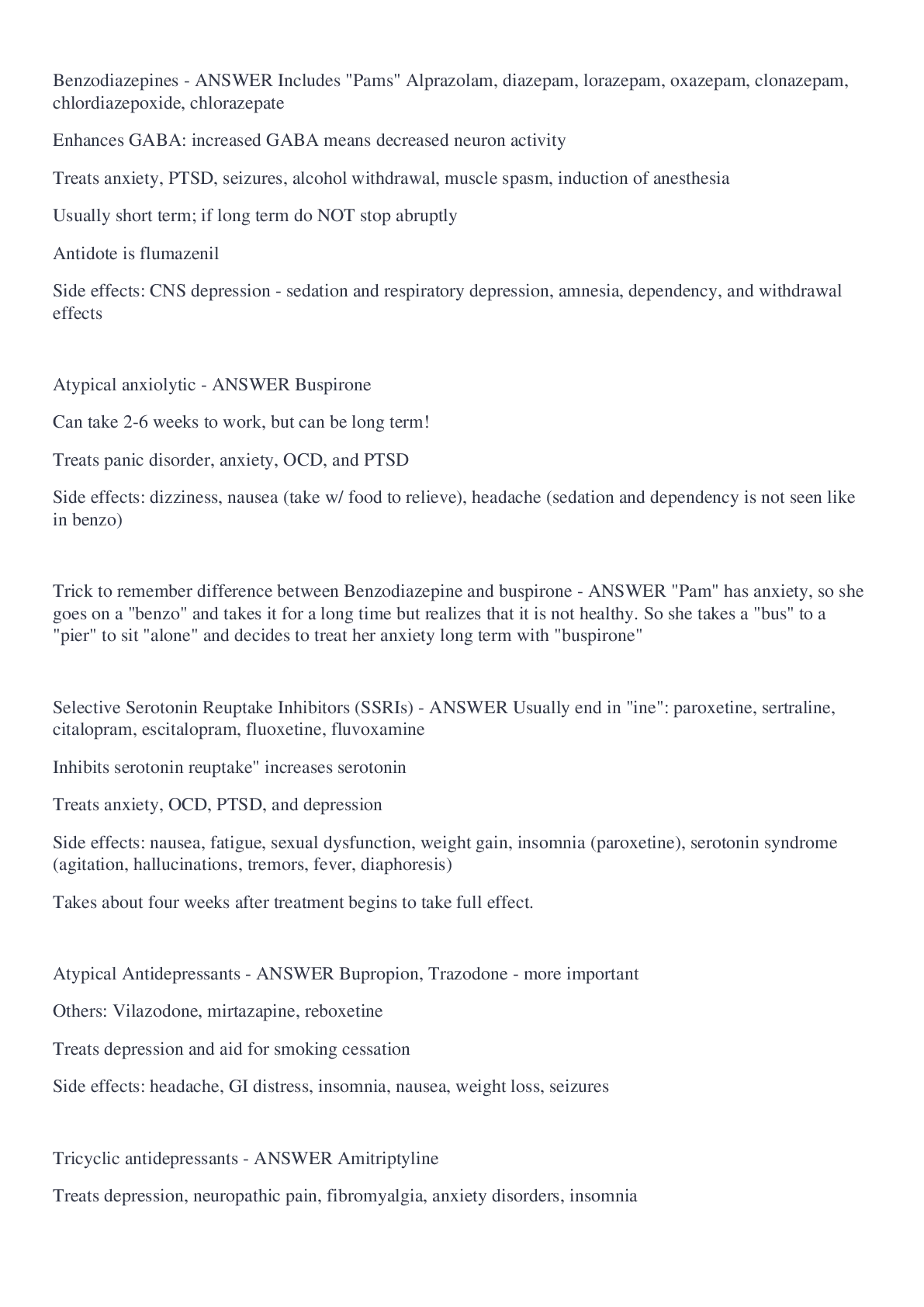
Reviews( 0 )
Document information
Connected school, study & course
About the document
Uploaded On
Aug 11, 2022
Number of pages
35
Written in
Additional information
This document has been written for:
Uploaded
Aug 11, 2022
Downloads
0
Views
38

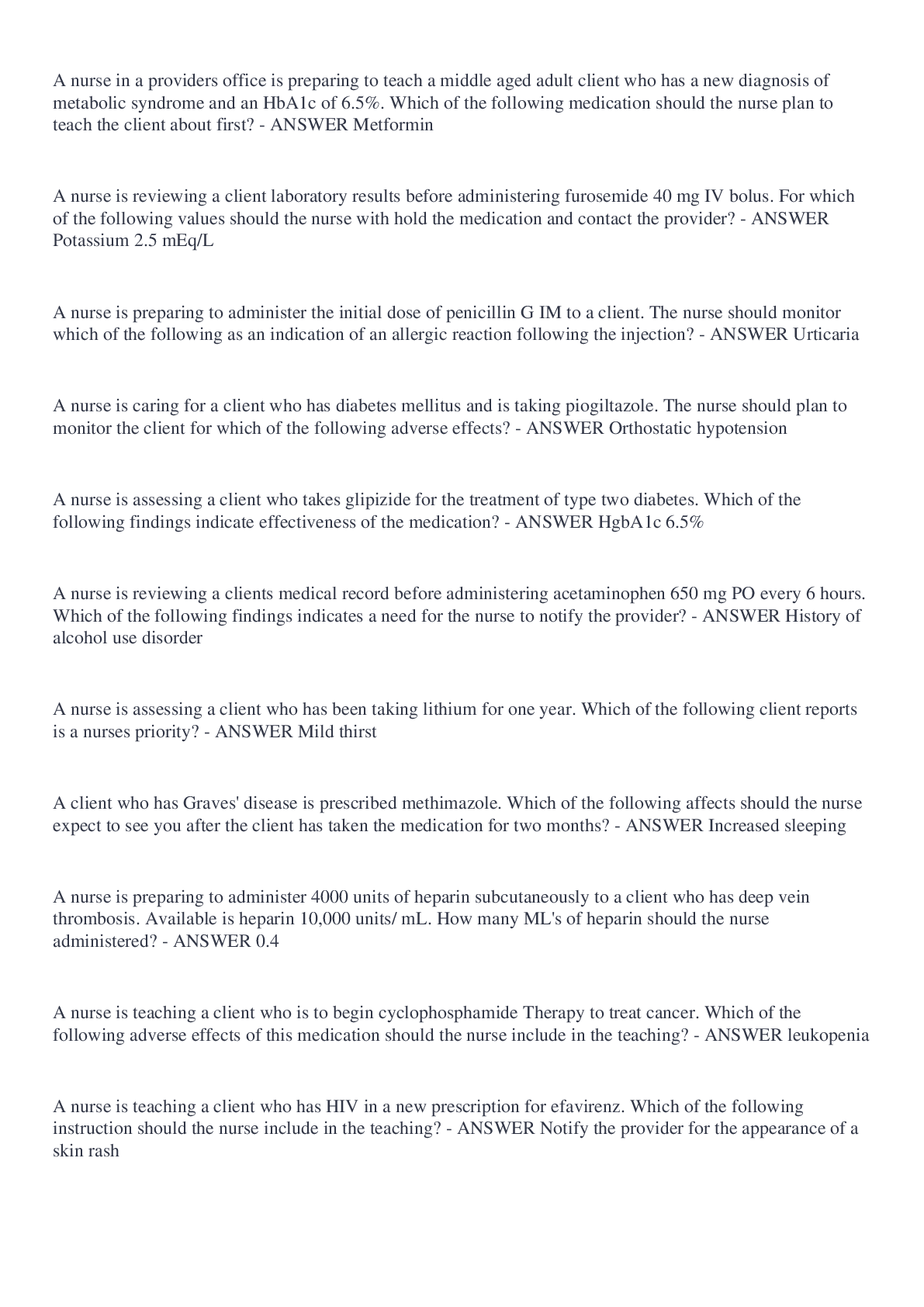
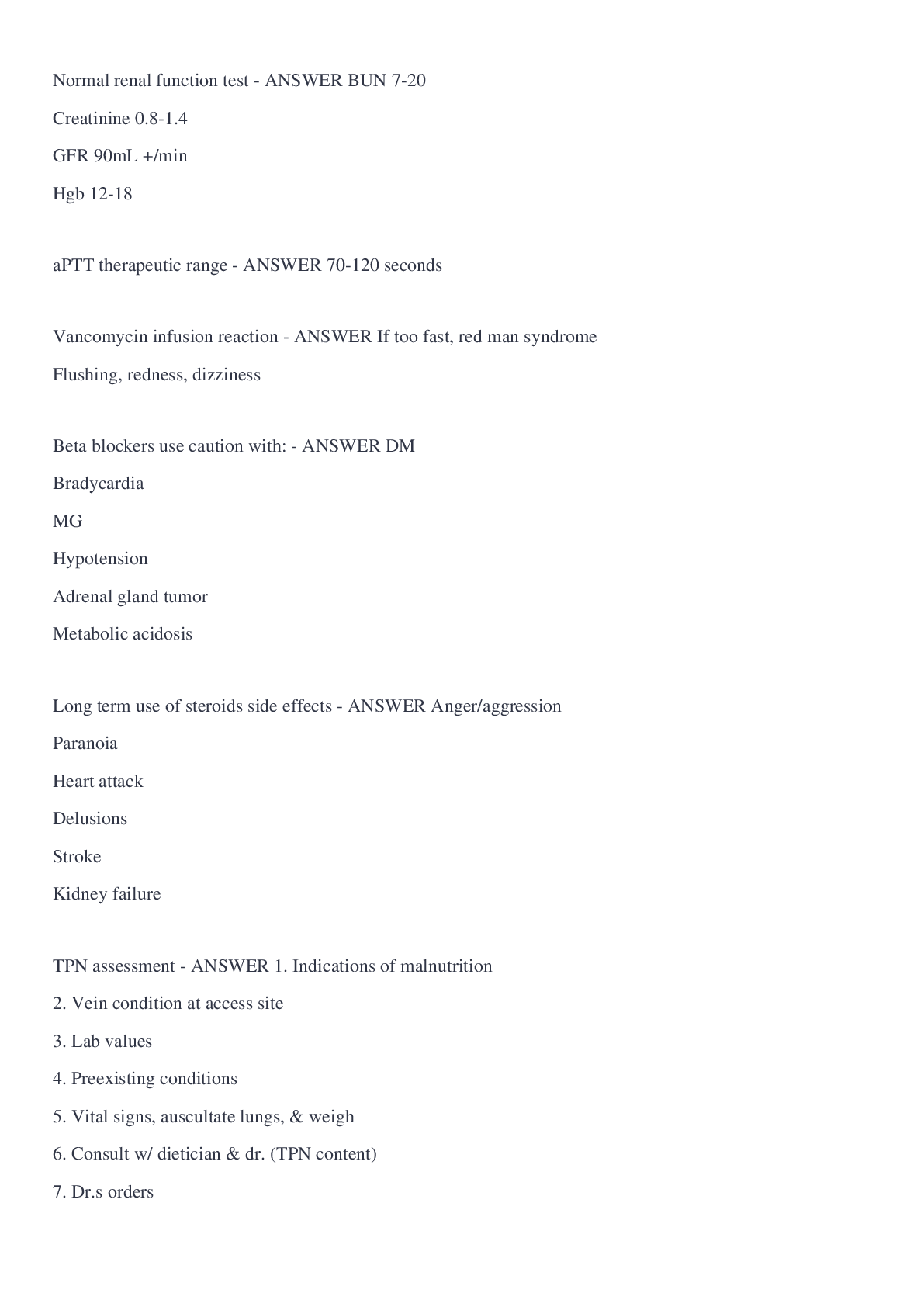
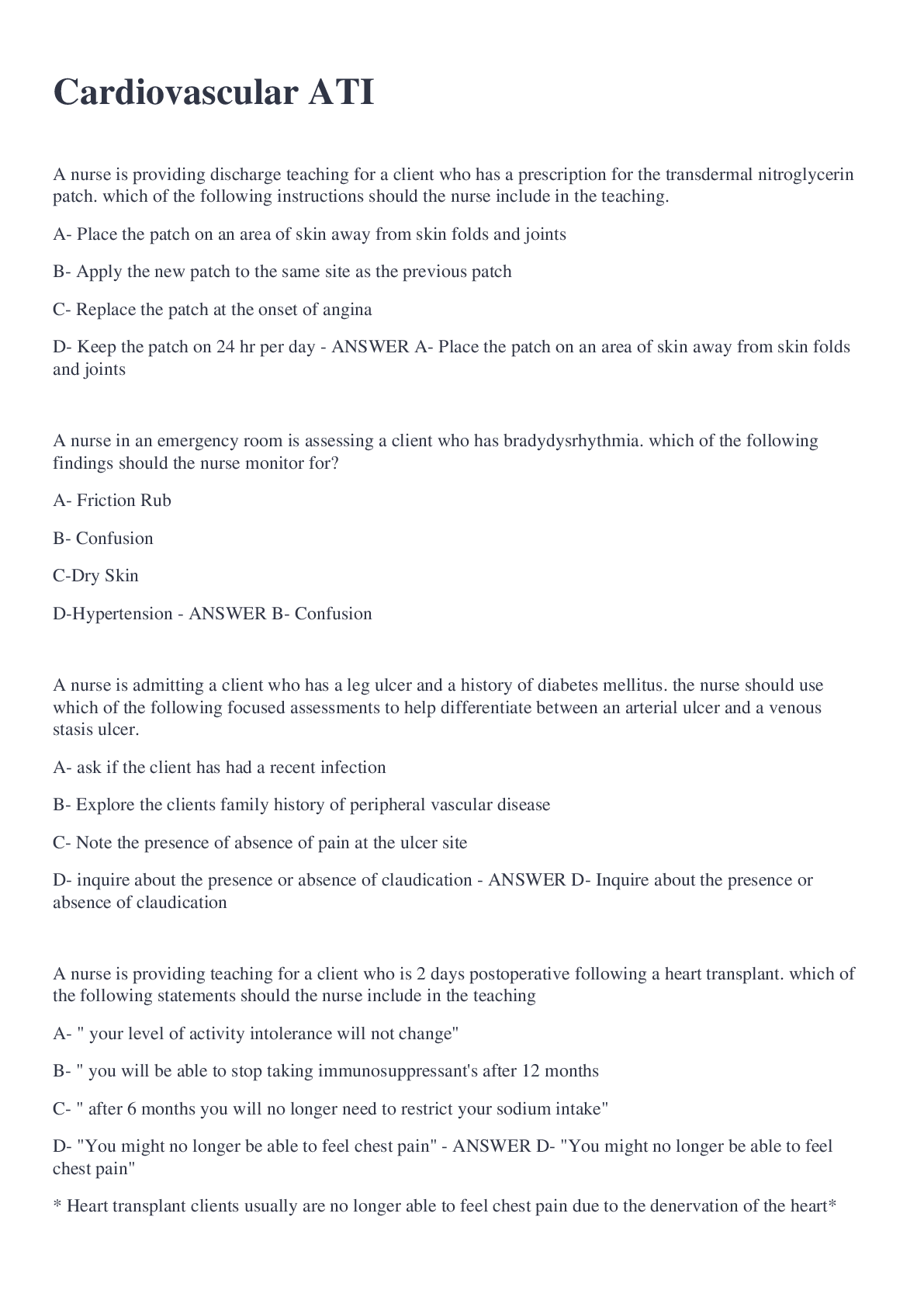


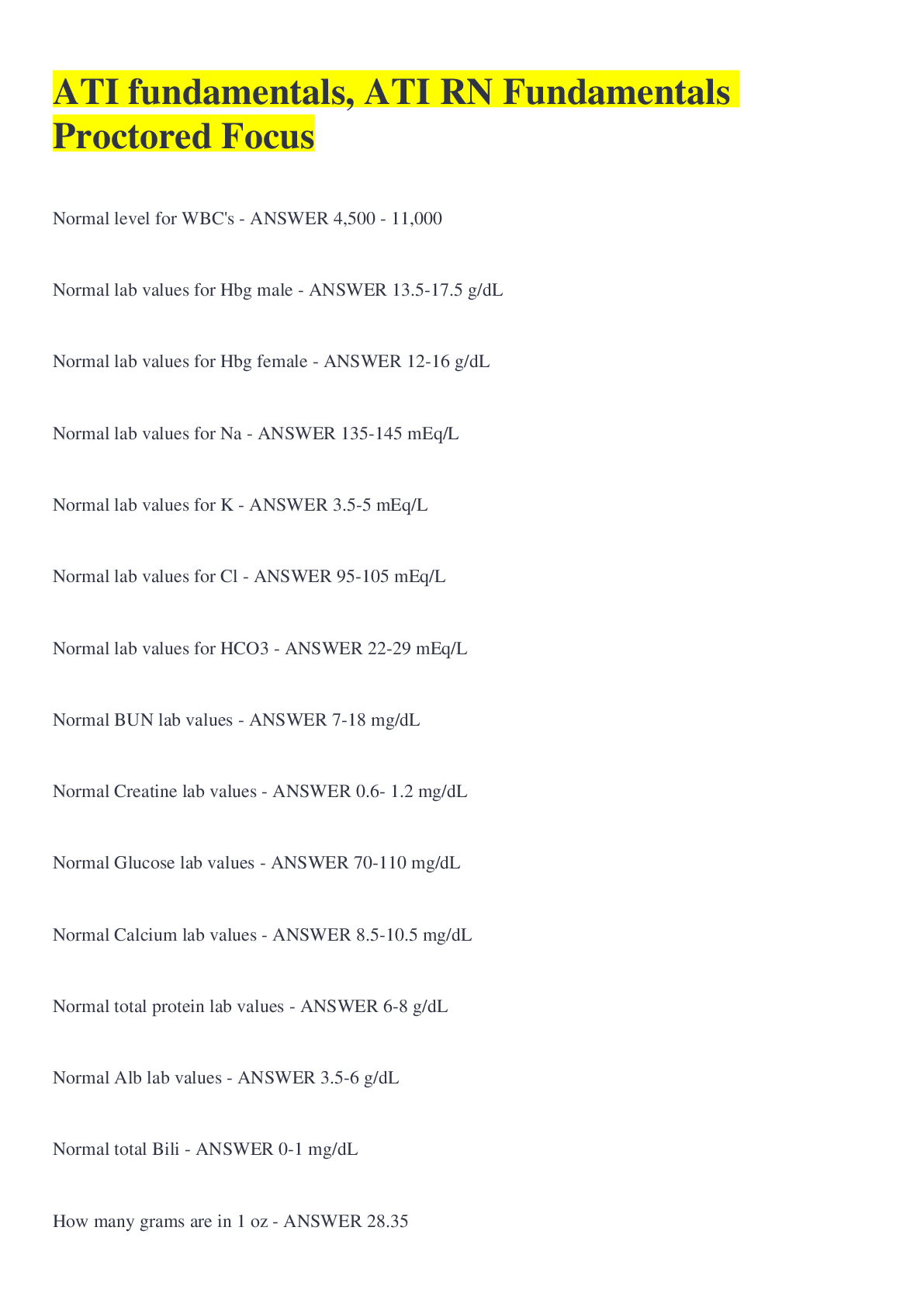
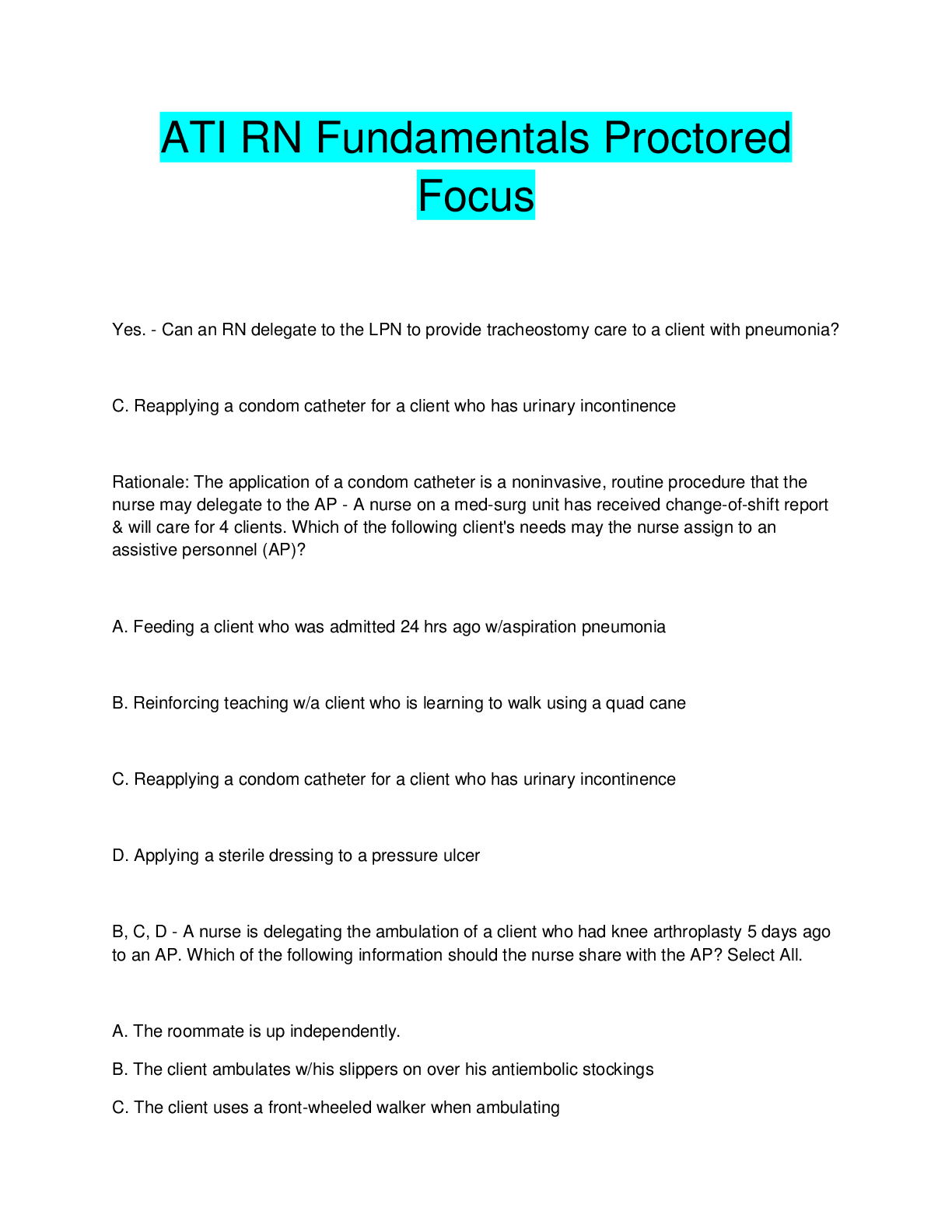
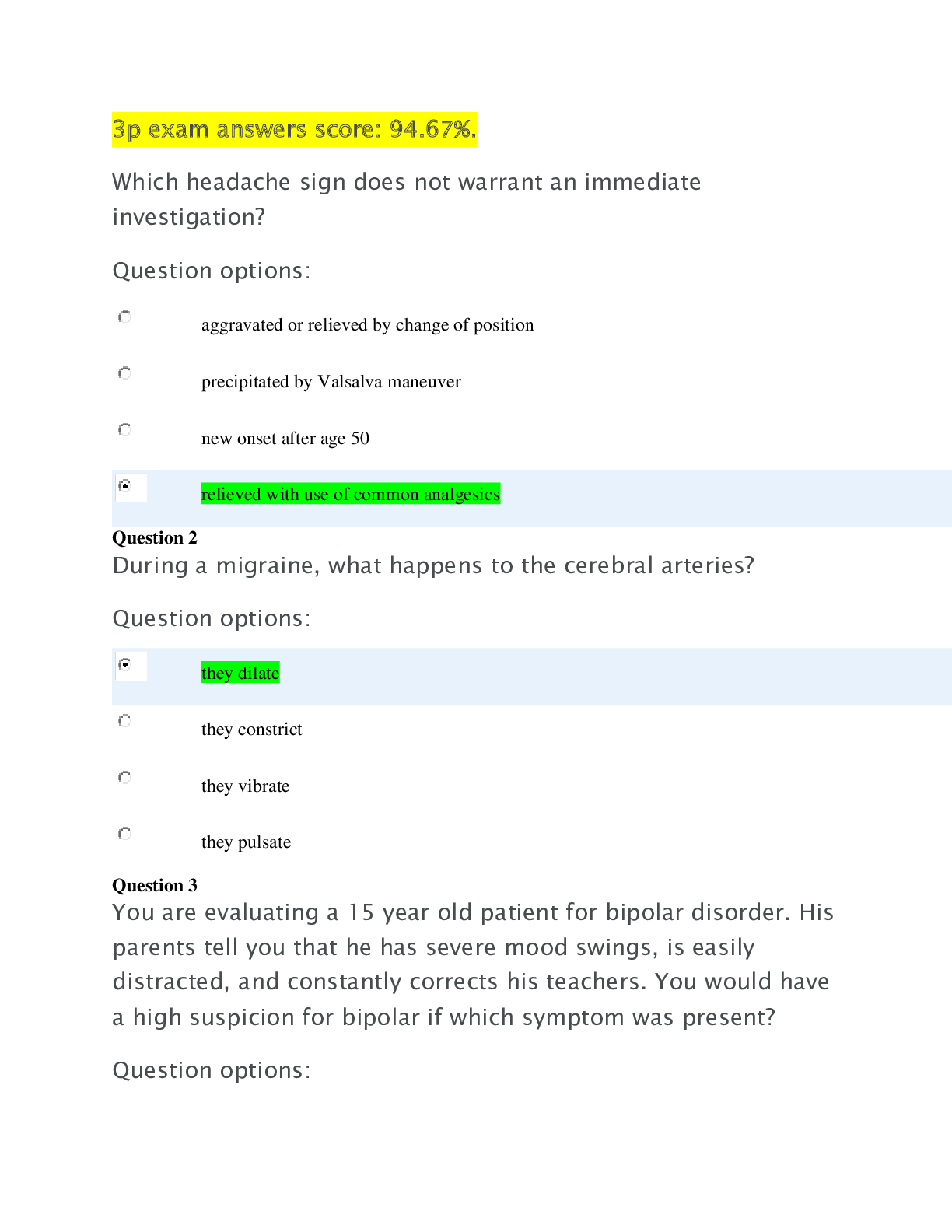


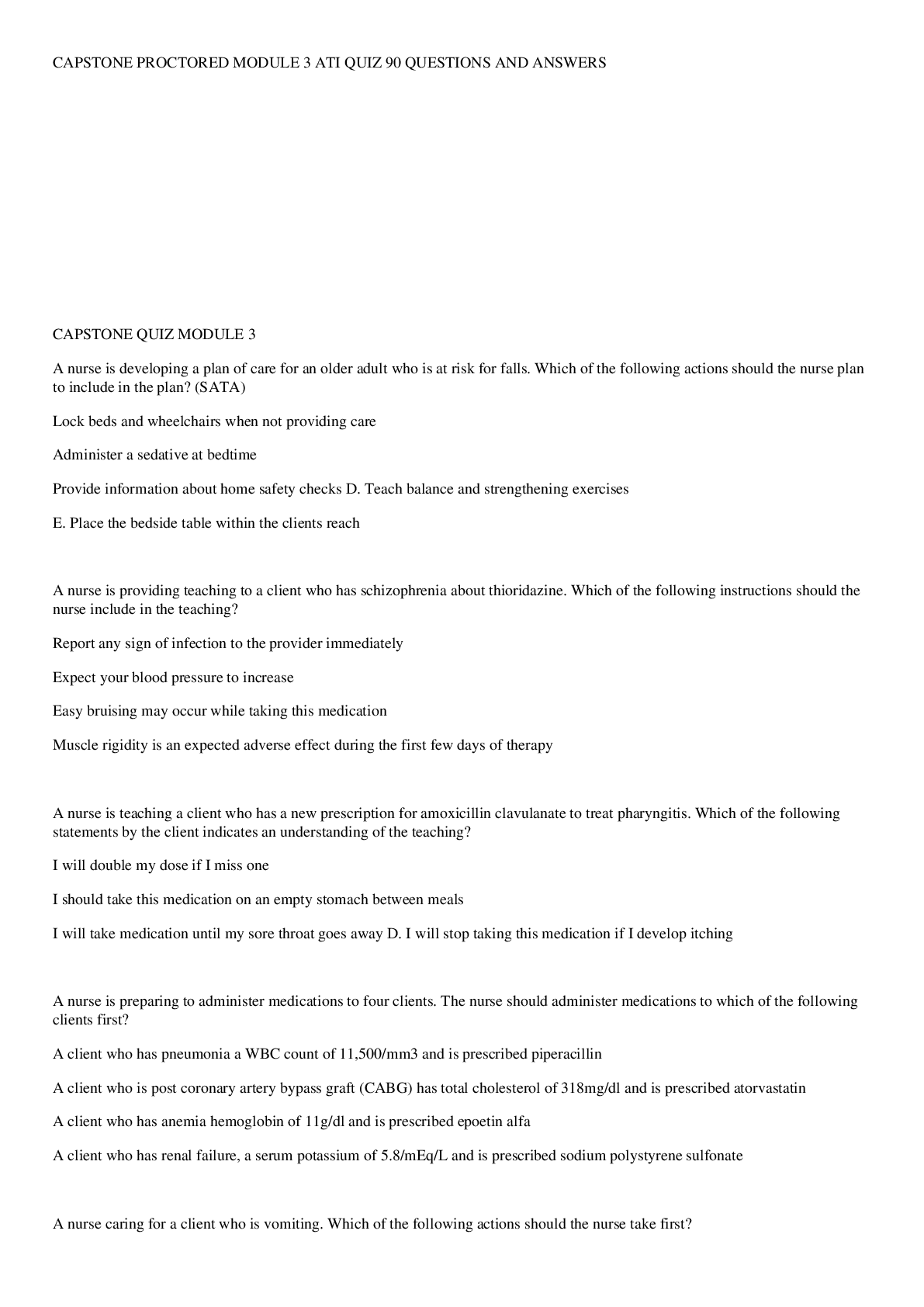
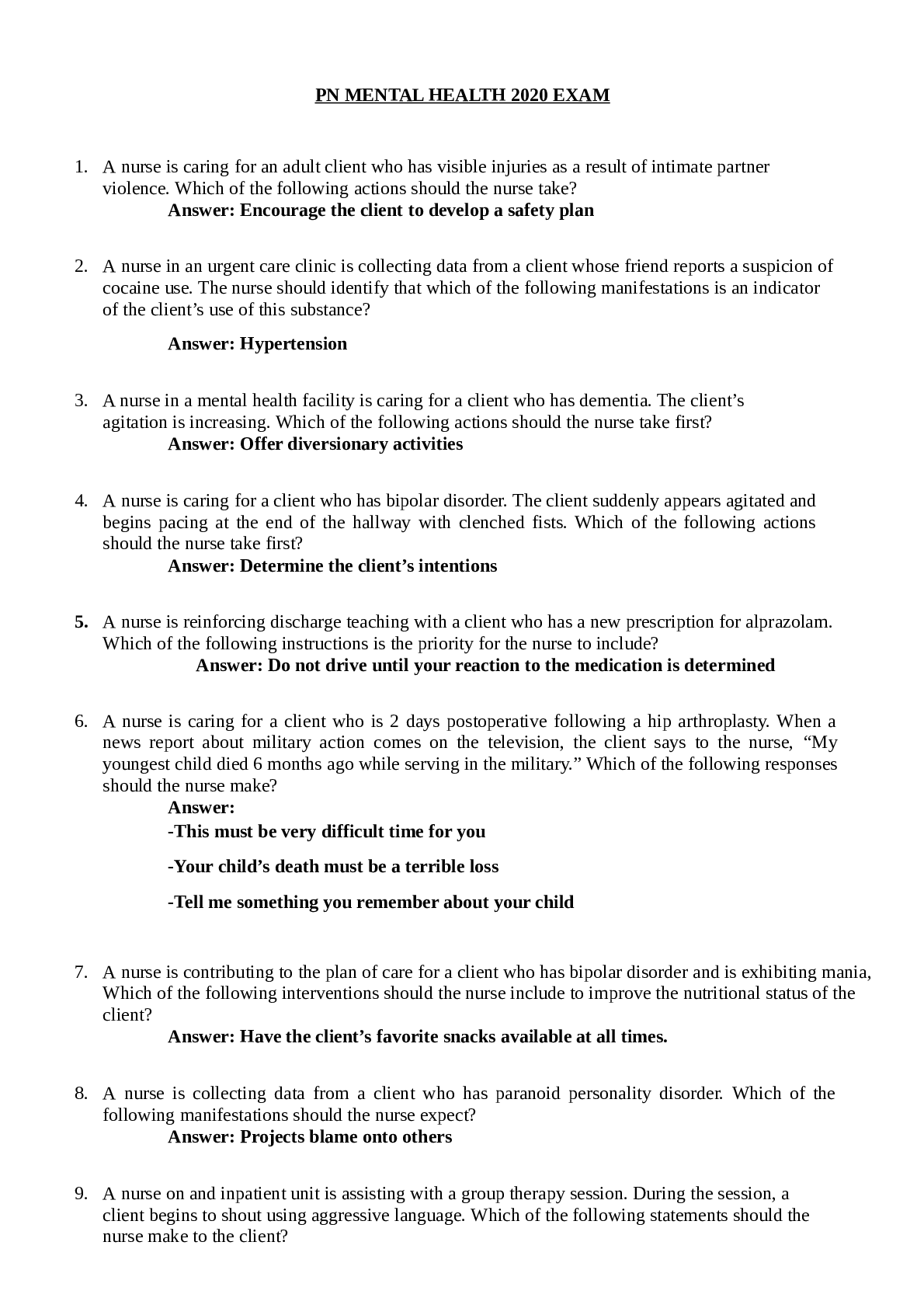

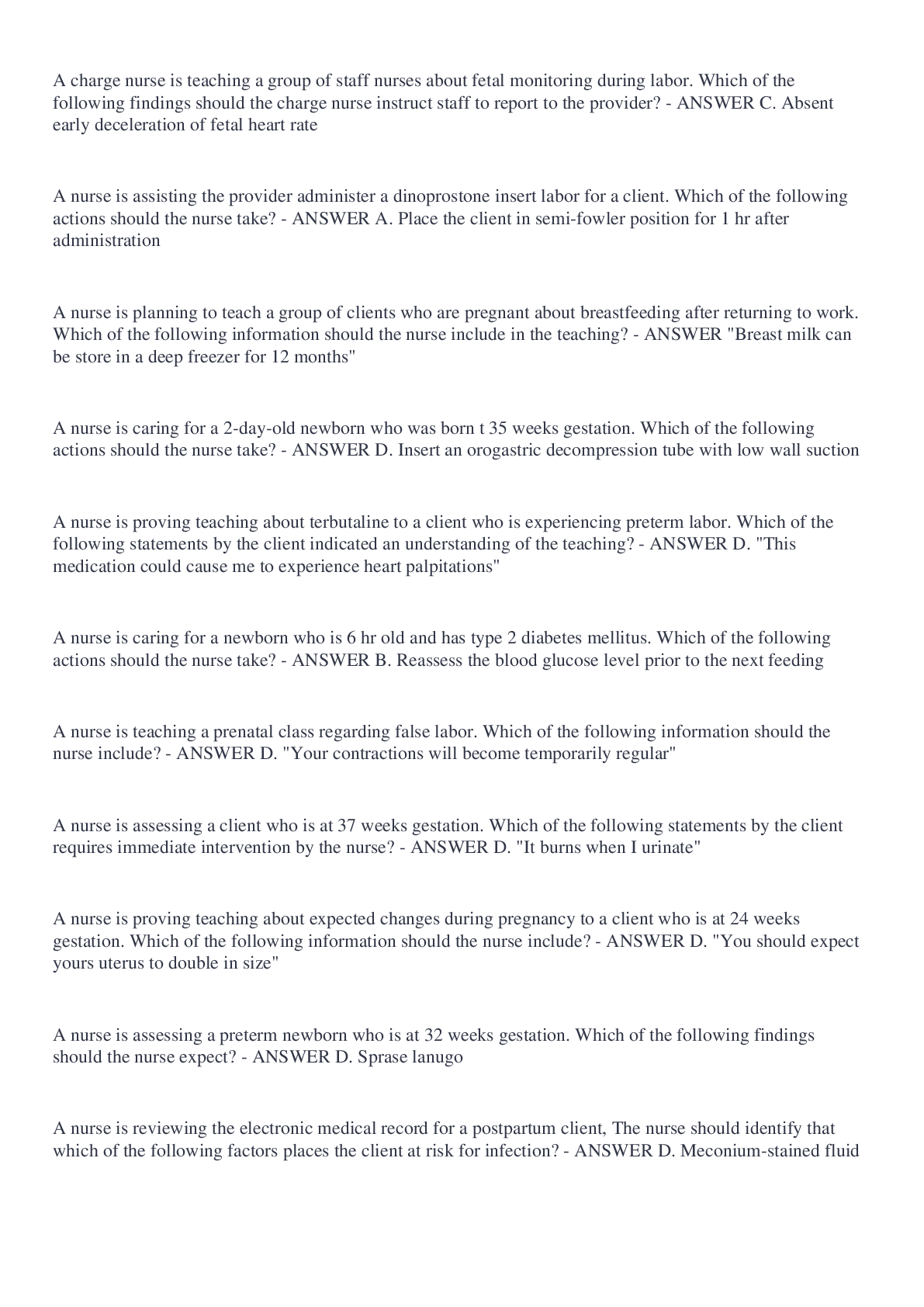


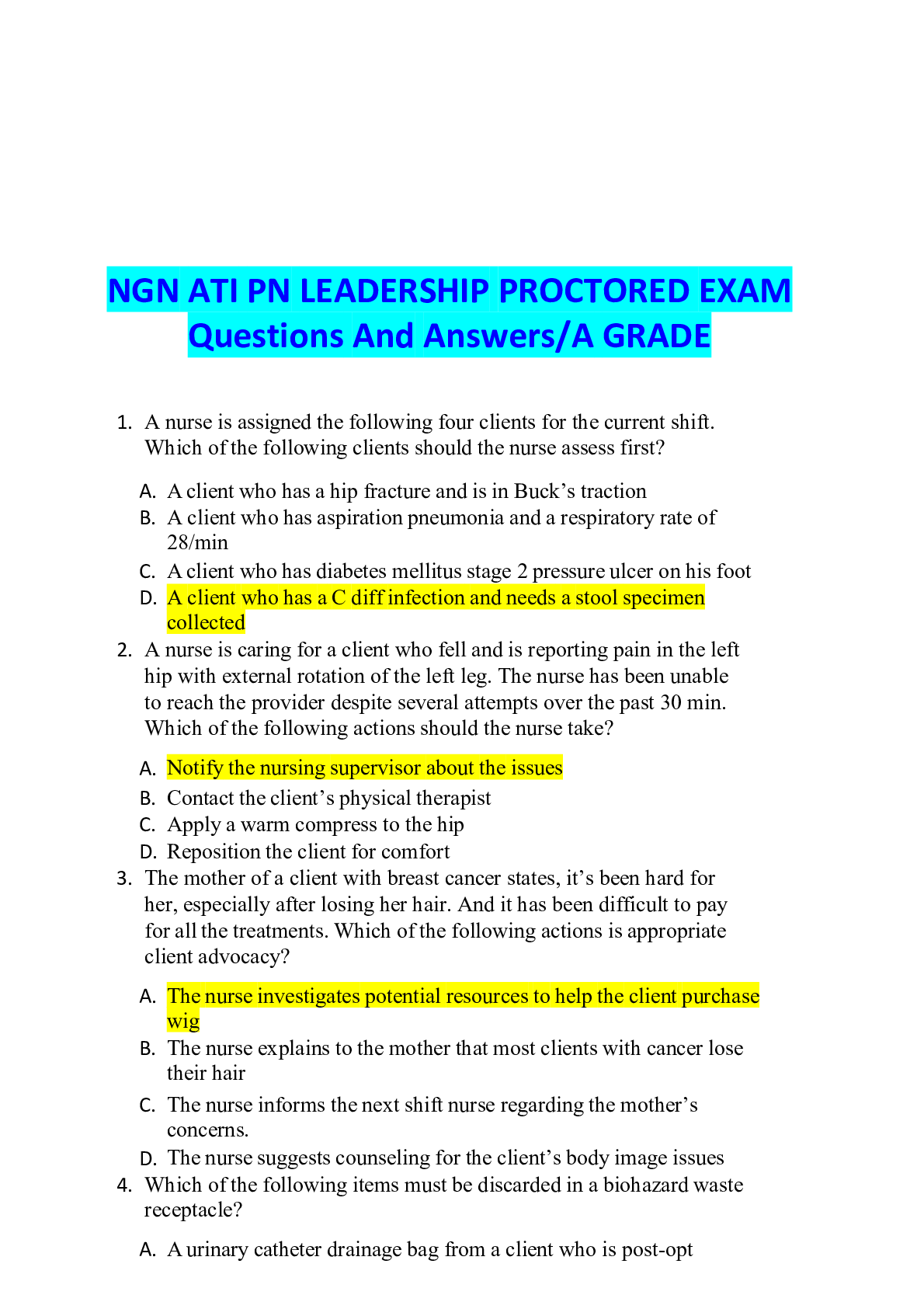

.png)

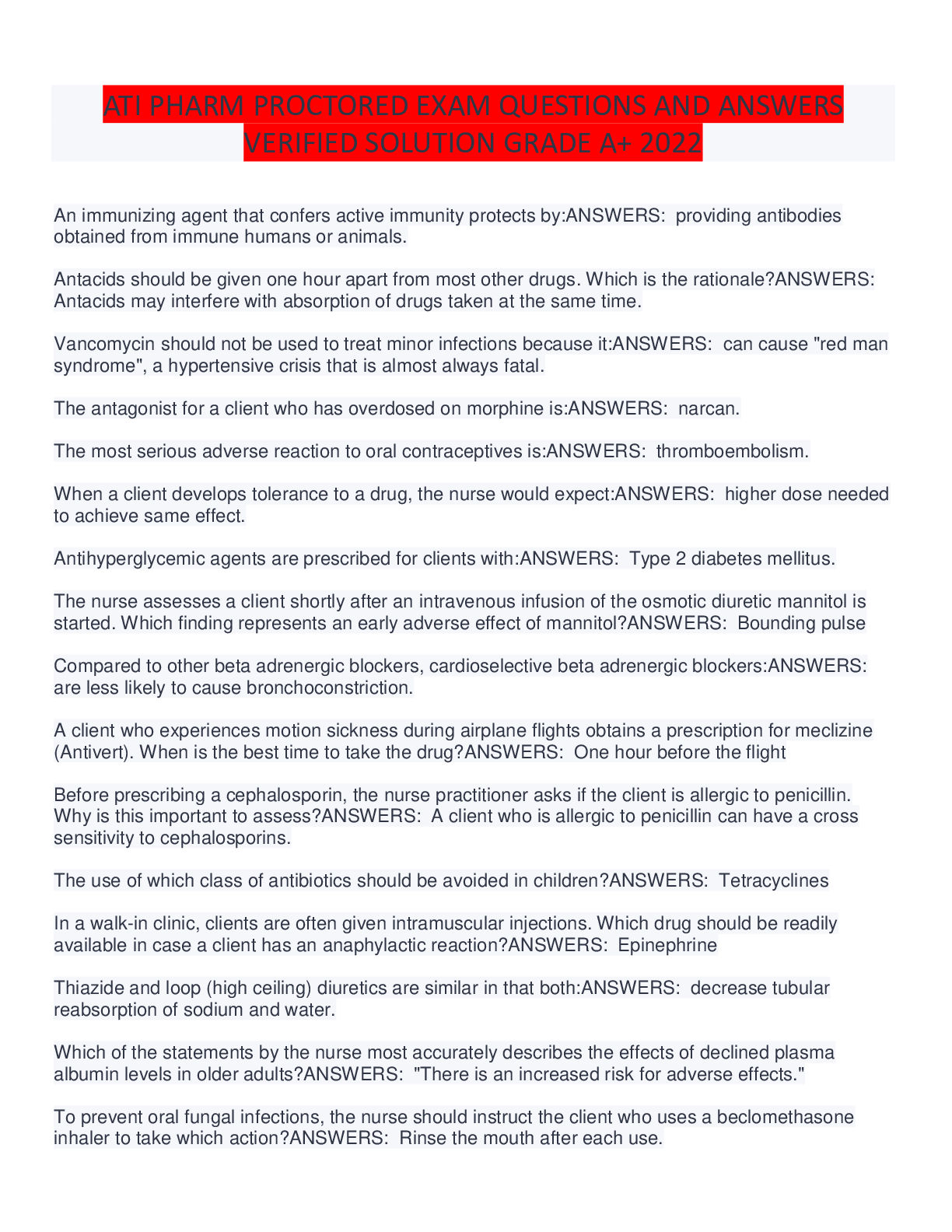
.png)
.png)
